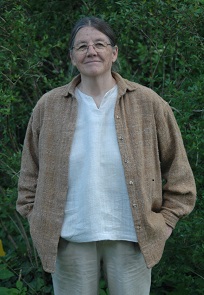
Marilyn Flax flowers.
The first of my flax plantings started to flower last week. I planted this bed on March 9 and it was 70 days later when I noticed the bed full of blooms. It is important to note the time of flowering so you can estimate when to harvest, especially if you are new at this.
Flax will bloom profusely for about a week or so. That is the time to have on record. Look forward to harvesting in about 30 days. You will still see flax flowers pop out, probably even up to harvest, but it is the major bloom time that you calculate 30 days from.

Marilyn Flax in bloom.
You could easily miss this great show if you only visit your garden in the afternoon or evening. The flowers themselves are short-lived. They will bloom before noon, then the petals will drop off. By later in the afternoon you wouldn’t know that the whole bed had been in bloom in the morning. So, if it has been two months since you planted flax in your garden, keep a mid-to-late morning eye out for the blooms.
It is time to harvest when the plants begin to turn yellow at the bottom. The tops will still be green and will have seed heads on them. In the photo you can see freshly harvested flax laid out on the ground next to a bed of flax still growing. I waited two more weeks to harvest that standing bed to give the seeds more time to mature. In 2016 I planted flax on March 8 and harvested the first bed on June 22 and the second bed on July 8. I live in Virginia in zone 7. Last year was my first year to grow flax, so my experience is limited, but I didn’t see much difference in the fiber from the two harvests. However, by waiting the two weeks, the seeds looked better. To harvest flax you pull it right out of the ground. Not cutting it, as I am used to doing with wheat and rye, was a surprise to me, but it sure made it easier. Usable fiber goes all the way into the root.

Harvested flax ready to bundle and a bed of flax ready to pull.
I have read that earlier harvested flax will yield finer fiber. In fact, in The Big Book of Flax, Christian and Johannes Zinzendorf say that if you are only after fiber you can pull the plants just after flowering when the plants are still green. If you want seed only, you can wait until the whole plants are brown. The fiber will not be usable, but you will have fully mature seed. I relied on what I’d read in Linen: From Flax Seed to Woven Cloth by Linda Heinrich and planned my harvest close to 100 days after planting and 30 days after major flower flush. Actual harvest of the first bed was 101 days after planting. I’m sure different weather conditions can affect harvest time, but this gives you an idea of what to look for. One year I might experiment with harvesting earlier and later.

Seed heads on flax ready to harvest.
When you pull the flax you will need to put it in bundles and dry it. A piece of flax can be used to tie each bundle together, or you can use a piece of twine for that. I lay the bundles against a fence to dry a bit before putting them away in my shed. Keep the flax stalks going the same way in each bundle, with the seed heads at one end and the roots at the other. The next step, called rippling, is to remove the seeds. It can be done at harvest or after the stalks have dried. The seed heads will be full of seed which are attractive to birds and rodents, so don’t delay.

Rippling flax by laying on solid surface and stepping on the seed heads.
I have seen plans for rippling combs made of wood, but you don’t need to bother with that. Just lay an old sheet or a tarp on a hard surface, place the stalks on it, and gently step on the seed heads. The bolls will pop open and spill their seeds right there. Nothing could be easier. In the photo you can see one bundle with the seed heads still on, and one bundle that has been stepped on. The seeds will need to be winnowed to remove the chaff.
My yield for the 80 sq. ft. bed that I harvested on July 8 last year was 6 oz. (170.1 g.) of fiber for spinning, 19 oz. (538.6 g.) of tow, and 6 oz. of seeds. Calculating the yield in terms of 100 sq. ft., that would be 7.5 oz (212.6 g.) of fiber, 23.75 oz. of tow (673.3 g.), and 7.5 oz. of seed per 100 sq. ft. I have not worked with the tow yet, but I know that I can salvage some for spinning. That flax was planted in rows. This year I broadcast all my flax so I expect my yield will be higher.
There is a lot to learn in order to turn flax into linen and it can be exciting. It is even more fun if you can do it with others. My handspinning group is having a flax-to-linen workshop in June, broadening the group of friends who have the skills to do it. I will be telling you about that in a future post. After rippling, the flax can be stored until the next step, which is retting. After that is the breaking, which is when you actually separate the fiber from the stalks. I will be writing about each step and what equipment you will need. A heads up about retting—you can lay it out in the grass and let the dew work on it, no pool of water necessary. Once you understand the whole process and actually work through it and have fiber to spin, doing it again will not seem so daunting.
Read Full Post »












